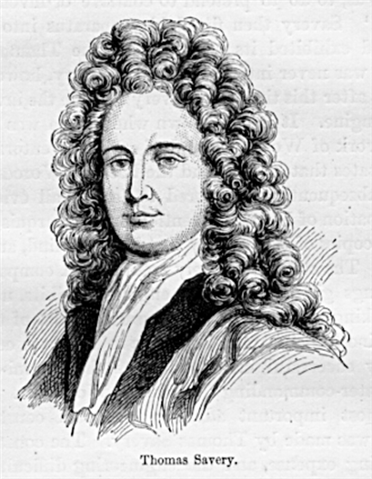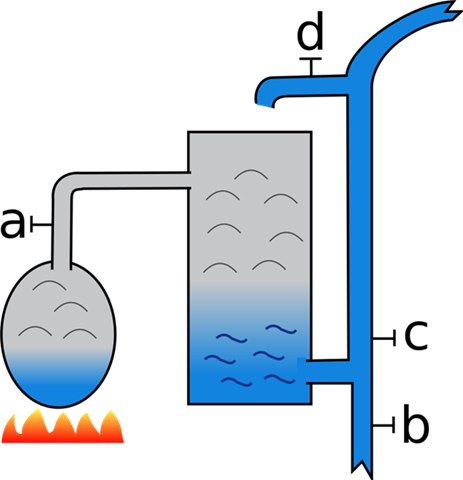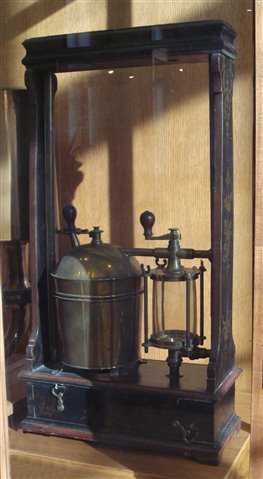Paradoxical as it may have seemed to society 300 years ago, water and fire could be joined and made productive. It just needed the right spark…
July 2, 1698 - Thomas Savery patents the first ‘steam engine’
It is 1698. The Industrial Revolution is still decades away. Muscles, be they human or animal, are the main sources of power to get most things done. Take tin and coal mines, for example. They are prone to flooding and the only way to remove the excess water is by a horse powered pulley system that raises the water in buckets.

Thomas Savery Source: Wikimedia Commons
What if this could be done by something akin to magic, but that is not magic? Gentleman, military engineer and inventor Thomas Savery has just the thing.
The ‘thing’ is what Mr Savery has patented today, July 2nd, although not before a demonstration of the engine in front of King William III at Hampton Court Palace. The document itself says nothing about the machine and how it works, except to say;
"A grant to Thomas Savery of the sole exercise of a new invention by him invented, for raising of water, and occasioning motion to all sorts of mill works, by the important force of fire, which will be of great use for draining mines, serving towns with water, and for the working of all sorts of mills, when they have not the benefit of water nor constant winds; to hold for 14 years; with usual clauses."

Source: Wikimedia Commons
Mr Savery’s engine consists of a boiler, a chamber, an up-pipe, a down-pipe, and valves fitted in the pipes.
The chamber is filled with water. The down-pipe valve is closed. Then, the boiler is heated by fire, creating high pressure steam. That steam moves into the water filled chamber forcing the water out through the up-pipe leading to the upper levels. The up-pipe valve is closed and the boiler heated again That creates steam, which moves into the now empty chamber. The chamber is rapidly cooled with a sprinkler to condense the steam. This creates a vacuum in the chamber. At that moment, the down-pipe valve is opened and the atmospheric pressure draws the water from the mine up to the chamber. The down-pipe valve is closed and the cycle begins again.
A second chamber was added to the engine so as one is filling with water, the other is expelling the water – making the process run relatively continuously.

A machine to raise water by fire, 1698 Source: Wikimedia Commons
The ‘Miner’s Friend’, was not the first attempt at designing a primitive steam engine. Edward Somerset, Marquis of Worcester had designed a similar device, constructed from the barrel of a cannon, for use in irrigation. Legend has it that our Mr Savery noticing the design in the Earl’s book, promptly bought up and destroyed every copy he could find.
While there appears to be no evidence for this, he gave a successful demonstration of the new steam pump to The Royal Society in June of 1699. In 1702 he published a prospectus on the miner’s friend, sending it to mine owners across the country, especially Cornwall..
As much as the Savery Engine was revolutionary, it had major problems, not all of which grew out of the design.
The Savery Engine was built using copper, brass and bronze. It was sealed using rivets and solder, but the technology of the time proved unequal to the task of preventing leaks. This compounded a flaw that was very much in the design, the use of high-pressure steam – which made the engine prone to explosions.
It required a lot of fuel to keep it going and its use of energy was poor.
The engine could pump water from a depth of 28 feet below it. It could pump water to a height of 28 feet above it. For a mine with a depth many times that, this was inadequate, and meant owners would have to set up a chain of Savery Engines to move water to the surface.
A steam powered water pump that was an explosion risk, working underground, was a clear danger to everyone in the mine, especially if there were several forming a chain to the surface.
The frequent explosions meant the miner’s friend was not widely used for pumping water out of mines. It did find use pumping water in a number of buildings, including Hampton Court Palace.
A new, more promising path
Enter Thomas Newcomen, blacksmith and preacher who Savery hired to forge his first steam pump. My Savery allowed Newcomen to use a steam pump in his own experiments, which eventually led to the invention of the ‘atmospheric steam engine.’ ‘Atmospheric’ because it used steam at atmospheric pressure which was condensed and then used to drive a piston.
Mr Savery’s patent was so wide ranging that Thomas Newcomen was forced to go into business with Mr Savery, who’s patent on ‘the steam engine’ didn’t lapse until 1733, 18 years after Thomas Savery died and four years after Newcomen’s own death.
The steam engine truly came into its own when James Watt improved its power and efficiency. The main driving force of the Industrial Revolution was ready for action.
By Stephen Phillips - IET Content Producer, with passions for history, engineering, tech and the sciences. 